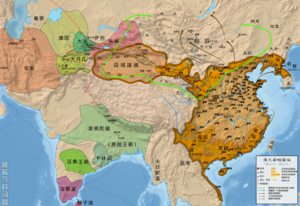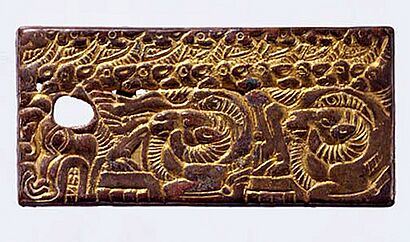Han–Xiongnu War facts for kids
Quick facts for kids Han–Xiongnu War漢匈戰爭 |
|||||||
|---|---|---|---|---|---|---|---|
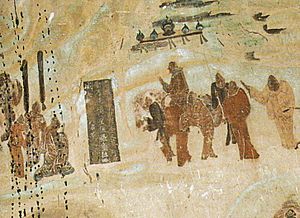 Emperor Wu dispatching the diplomat Zhang Qian to Central Asia, Mogao Caves mural, 8th century |
|||||||
|
|||||||
| Belligerents | |||||||
| Xiongnu Qiang Wuhuan |
Han dynasty Xin dynasty (9–23 AD) Tributary and allied forces: Southern Xiongnu Qiang Wuhuan Xianbei Wusun |
||||||
| Commanders and leaders | |||||||
| Junchen Chanyu Yizhixie Chanyu Hunye Chanyu Xiutu Chanyu † Zhizhi Chanyu † ...and others |
Emperor Wu of Han General Wei Qing General Huo Qubing General Dou Gu General Ban Chao General Dou Xian General Li Guang ...and others |
||||||
The Han–Xiongnu War was a long series of fights between the powerful Han Empire of China and the Xiongnu, a group of nomadic people from the steppes. These conflicts lasted for about two centuries, from 133 BC to 89 AD. However, smaller clashes happened even earlier, around 200 BC.
Before the Han Empire, Chinese states like the Qin dynasty often fought with nomadic tribes. They built long walls, which later became part of the Great Wall of China, to protect themselves. General Meng Tian of the Qin dynasty successfully pushed the Xiongnu away from the Ordos region in 215 BC. But after the Qin dynasty fell, the Xiongnu, now united under a strong leader named Modu Chanyu, took back the Ordos region.
When the Western Han dynasty was formed, its first emperor, Emperor Gao, tried to fight the Xiongnu. But he was trapped in a battle and had to make a peace deal. For decades, China tried to keep peace by offering "marriage alliances" (called heqin), where Chinese princesses were married to Xiongnu leaders. But the Xiongnu still often raided Chinese lands.
This changed when Emperor Wu became emperor. He decided to stop being passive and actively fight the Xiongnu to end the threat. The war officially began in 133 BC when the Han army tried to ambush Xiongnu raiders but failed. Emperor Wu then sent out new, strong generals like Wei Qing and Huo Qubing. They led many expeditions, pushing the Xiongnu far north beyond the Gobi Desert by 119 BC.
After Emperor Wu died in 87 BC, the fighting slowed down, but the Han Empire had already become very powerful in Central Asia. The Xiongnu, on the other hand, became weaker and split into different groups. The Han Empire used a "divide and rule" strategy, making alliances with some Xiongnu groups against others.
Later, during the short-lived Xin dynasty (9–23 AD), the Xiongnu fought back. But after the Eastern Han dynasty was established in 25 AD, the Xiongnu faced natural disasters and further attacks. In 48 AD, they permanently split into two main groups: the Northern Xiongnu and the Southern Xiongnu. The Southern Xiongnu eventually joined the Han Empire and helped them fight the Northern Xiongnu.
In 89 AD, General Dou Xian led a huge Han army that decisively defeated the Northern Xiongnu. The Northern Xiongnu were pushed further west and eventually disappeared from historical records. The Southern Xiongnu remained allies of the Han Empire, though they sometimes rebelled. After 89 AD, the Han Empire focused more on other groups, like the Qiang people, who became a new challenge.
Contents
Early Conflicts and Peace Deals
Before the Han dynasty, during the Warring States period, Chinese states like Qin, Zhao, and Yan fought with the Xiongnu. They built long walls to protect their borders. In 221 BC, the Qin dynasty united China. In 215 BC, the first Qin Emperor sent General Meng Tian to attack the Xiongnu in the Ordos Desert. Meng Tian defeated them and took their land. The Xiongnu leader, Touman Chanyu, and his people fled to the Mongolian Plateau. The Qin then connected and extended the walls to protect their empire. This expansion made the Xiongnu tribes unite into a stronger group.
However, after the Qin Emperor died, China fell into civil war. While the Chinese were busy fighting each other, the Xiongnu took back their land north of the Great Wall. They often raided the Han border. In 200 BC, Emperor Gaozu, the first Han emperor, led an army against the Xiongnu. But he was ambushed and trapped for seven days. After this, he realized that fighting wasn't working.
So, in 198 BC, Emperor Gaozu made a peace deal called a "marriage alliance" (heqin) with the Xiongnu. This meant the Han would give gifts and princesses to the Xiongnu to keep the peace. But even with this deal, Xiongnu raids on the border continued.
The War Begins
By the time Emperor Wu became emperor, the Han Empire was rich and strong. But the constant Xiongnu raids were a big problem. Emperor Wu decided to change the old policy of peace. In 136 BC, after more Xiongnu attacks, he held a meeting with his officials. They decided to try a trick: they would lure the Xiongnu leader, Junchen Chanyu, into a trap at a place called Mayi.
In 133 BC, a huge Han army of 300,000 soldiers waited in ambush at Mayi. Junchen Chanyu led his army of 100,000 men towards Mayi. But he became suspicious and realized it was a trap. He quickly fled north. Because the ambush failed, the peace was completely broken. Both sides now knew that a full-scale war was coming. The Han Empire was ready, with strong armies and a government that wanted to fight.
Early Han Attacks
In 129 BC, Han cavalry launched a surprise attack on Xiongnu trading markets. In 128 BC, General Wei Qing led 30,000 men and won a battle north of Yanmen Pass. The next year, the Xiongnu attacked again, but Wei Qing and Li Xi pushed them back.
Between 127 and 119 BC, Emperor Wu ordered Generals Wei Qing and Huo Qubing to lead many large military campaigns against the Xiongnu. These campaigns involved tens of thousands of soldiers.
Taking Back the Ordos Region
In 127 BC, General Wei Qing took back full control of the Ordos Loop region. After this victory, about 100,000 Chinese people were moved to settle in the Ordos. The Han also repaired and extended the old Qin walls there. In 126 BC, the Xiongnu tried to raid again, but Wei Qing defeated them, capturing 15,000 men and 10 tribal chiefs.
Pushing North of the Gobi
In 123 BC, General Wei Qing attacked the Xiongnu in Mongolia again. After these Han attacks, the Xiongnu moved their capital and retreated far north into the Gobi Desert.
Controlling the Hexi Corridor
In 121 BC, the Han forces dealt a major defeat to the Xiongnu in the Hexi Corridor. Emperor Wu wanted to control this area. General Huo Qubing led this campaign. He rode with light cavalry through five Xiongnu kingdoms, conquering the Yanzhi and Qilian mountain ranges.
Huo Qubing's army captured or killed about 18,000 Xiongnu cavalry. Later that summer, he attacked the Xiongnu at the Qilian Mountains. The Hunye King saw 30,000 of his troops die in battle.
Because of these huge losses, the Xiutu King and the Hunye King planned to surrender to Huo Qubing. The Xiutu King changed his mind and fled, but Huo Qubing and the Hunye King chased him down and killed him and 8,000 of his troops. In the end, the Hunye King and 40,000 Xiongnu soldiers surrendered to the Han Empire. This victory cut off the Xiongnu from their allies, the Qiang people. The Han then set up four commanderies (regions) in the Hexi Corridor and settled Chinese people there.
Battle of Mobei
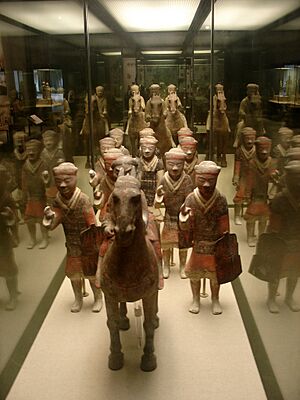
The Battle of Mobei in 119 BC was a huge Han victory. Generals Wei Qing and Huo Qubing led two separate armies into the northern Gobi Desert and beyond. Their goal was to find and defeat the main Xiongnu forces.
Together, the two armies had 100,000 cavalrymen, 140,000 horses, and hundreds of thousands of foot soldiers. They chased the Xiongnu leader, the Chanyu, north of the Gobi Desert. The Xiongnu lost between 80,000 and 90,000 troops, while the Han lost 20,000 to 30,000. The Han also lost about 100,000 horses during the campaign.
Huo Qubing's army killed about 70,000 Xiongnu soldiers. He even went as far as Lake Baikal. Wei Qing's army faced the Xiongnu Chanyu's army. Wei Qing used a clever tactic: he arranged heavy chariots in a circle to create mobile forts. This protected his archers and foot soldiers from Xiongnu cavalry charges. A sandstorm helped the Han cavalry to surround the Xiongnu army. The Chanyu managed to escape, but it was a major defeat for the Xiongnu.
Controlling the Western Regions

After the Han took the Hexi Corridor in 121 BC, the city-states in the Tarim Basin were caught between the Han and the Xiongnu. Both empires wanted control of these regions for trade and resources. The Han sent several military expeditions to make these local kings submit to them.
By 115 BC, the Han had set up commanderies at Jiuquan and Wuwei. They also extended the Great Wall to Dunhuang. From 115 to 60 BC, the Han and Xiongnu fought for control of these states. The Han Empire grew stronger in eastern Central Asia as the Xiongnu weakened. The Han brought states like Loulan, Jushi (Turfan), and Dayuan (Ferghana) under their influence. The long wall protected people and trade routes, and it helped separate the Xiongnu from their Qiang allies.
In 115 BC, the diplomat Zhang Qian was sent to the Western Regions again to find allies against the Xiongnu. He didn't find allies, but he learned a lot about the region, especially about the large and powerful "heavenly horses" from Ferghana. Emperor Wu believed these horses were very important for fighting the Xiongnu. When the Dayuan kingdom (Ferghana) refused to provide these horses and killed a Han envoy, it led to a war. The Han forces defeated Dayuan in 101 BC. The Xiongnu tried to stop the Han, but they were defeated.
In 108 BC, General Zhao Ponu invaded Jushi (Turfan), a key Xiongnu stronghold. The Han forces pushed back all Xiongnu attempts to retake it. The kingdom of Loulan became unfriendly to the Han, even allowing Han envoys to be killed. In 77 BC, a Han envoy named Fu Jiezi assassinated the King of Loulan. The Han then put the king's younger brother, who was friendly to the Han, on the throne. Loulan was renamed Shanshan, and its capital was moved away from Xiongnu influence.
The Xiongnu also made marriage alliances with Han generals who switched sides. For example, the Xiongnu ruler's sister married a Han general who defected. The daughter of the Chanyu married the Han Chinese General Li Ling after he surrendered.
Xiongnu Weakness and Internal Fights
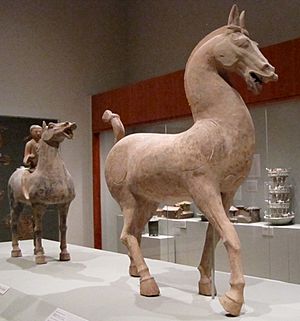
As the Xiongnu became weaker, some of their enslaved people rebelled. Around 80 BC, the Xiongnu attacked the Wusun people, who asked the Han for help. In 72 BC, the Han and Wusun forces attacked the Xiongnu, capturing 40,000 Xiongnu people and much livestock. The next year, various tribes like the Dingling and Wuhuan also attacked the Xiongnu from different directions. The Han forces attacked from the south. This period marked the beginning of the Xiongnu's decline.
Xiongnu Civil War
The Xiongnu tried to make peace with the Han several times, but the Han always demanded that the Xiongnu become their vassals (a state that owes loyalty and tribute). After the death of Xulüquanqu Chanyu in 60 BC, a civil war broke out among the Xiongnu in 57 BC. This split the Xiongnu into many groups. In the end, only Zhizhi Chanyu and Huhanye Chanyu remained as main leaders.
After Zhizhi Chanyu defeated Huhanye Chanyu, Huhanye decided to ask the Han Empire for protection and become their vassal. In 53 BC, Huhanye surrendered to the Han. He sent his son as a hostage to the Han court. In 51 BC, he personally visited Emperor Xuan to show his respect.
In 36 BC, two Han generals, Chen Tang and Gan Yanshou, decided to act without direct permission from the Han court. They led 40,000 troops and attacked Zhizhi Chanyu at his capital city (in present-day Kazakhstan). They defeated Zhizhi Chanyu's forces and killed him. Even though the generals had forged an imperial order, they were pardoned and given small rewards because of their victory.
Final Decline of Xiongnu Power
In 9 AD, a Han official named Wang Mang took over the Han throne and started a new dynasty called Xin. He treated the Xiongnu very poorly, and relations quickly worsened. Wang Mang gathered 300,000 troops along the northern border, which stopped the Xiongnu from launching big attacks. When the Eastern Han dynasty was restored in 25 AD, its control over the Tarim Basin was weak. The Xiongnu took advantage and regained control of the Western Regions.
In the first half of the 1st century AD, the Xiongnu faced several leadership crises. This allowed the Han Empire to regain control over the Western Regions. In 46 AD, the Xiongnu leader Huduershi Chanyu was succeeded by his son, Punu, which broke an old rule about succession. This angered Bi, Huduershi's nephew, who was declared a rival Chanyu by eight southern Xiongnu tribes in 48 AD. The Xiongnu confederation then officially split into the Northern Xiongnu and Southern Xiongnu. Bi and the Southern Xiongnu submitted to the Han Empire in 50 AD. The Han took control of the Southern Xiongnu, who had about 30,000-40,000 soldiers.
Between 73 and 102 AD, General Ban Chao led several expeditions into the Tarim Basin, bringing the region back under Han control. Ban Chao was very bold. At the capital of Shanshan, he killed a Northern Xiongnu envoy and showed their heads to the king, who then submitted to the Han. When he visited Yutian (Khotan), the king was rude. Ban Chao killed the king's soothsayer for insulting him. Impressed by this, the king killed a Xiongnu agent and submitted to the Han. Ban Chao continued west, capturing King Douti of Kashgar, who was allied with the Xiongnu.
In 73 AD, General Dou Gu led his army against the Northern Xiongnu, defeating them and pushing them back. He then set up a military base at Hami. In 74 AD, Dou Gu retook Turfan from the Xiongnu. These Han campaigns forced the Northern Xiongnu to retreat. Ban Chao continued to bring the city-states in the Tarim Basin under Han control.
Later in 74 AD, the kingdoms of Karasahr and Kucha were forced to surrender to the Han. However, the Northern Xiongnu soon attacked again, and their allies killed the Han Protector General. This forced the Han garrison at Hami to withdraw until 91 AD.
Final Battles
In 89 AD, General Dou Xian led a major Han expedition against the Northern Xiongnu. His army, totaling 40,000 troops, attacked the Xiongnu near Zhuoye Mountain. Dou Xian's forces chased the Northern Chanyu into the Altai Mountains, killing 13,000 Xiongnu and accepting the surrender of 200,000 Xiongnu from 81 tribes. This victory effectively destroyed the Xiongnu state. In 2017, an inscription celebrating this victory was rediscovered in Mongolia.
After the War

In 90 AD, General Dou Xian sent forces to attack the remaining Xiongnu defenses in the Western Regions. They captured Yiwu and received the surrender of Jushi. Dou Xian planned for the Northern Chanyu to formally submit to the Han court, but this didn't happen.
Instead, in 90 AD, Dou Xian sent General Geng Kui and a Southern Xiongnu leader with 8,000 cavalry to attack the Northern Chanyu. They surprised the Chanyu, who was forced to flee, leaving his family and official seal behind. The Han killed 8,000 Xiongnu men. In 91 AD, General Geng Kui pursued the Northern Chanyu into the Altai Mountains, killing 5,000 more Xiongnu. The Northern Chanyu escaped to an unknown place. By 91 AD, the last parts of the Northern Xiongnu had moved west towards the Ili River valley and disappeared from history.
The Southern Xiongnu, who had settled in the Ordos region around 50 AD, remained semi-independent allies of the Han Empire. They relied on the Han for support. After the victories against the Xiongnu, General Ban Chao was promoted and stationed in Kucha in 91 AD. He made sure the Han had full control over the Western Regions.
Impact of the War
Military Changes

Early on, a minister named Chao Cuo suggested that the Han army should use more cavalry (soldiers on horseback) to fight the Xiongnu. Before this, Han armies mainly used foot soldiers. He also suggested using "barbarians to attack barbarians," meaning incorporating surrendered Xiongnu and other nomadic tribes into the Han military.
In 169 BC, Chao Cuo compared Xiongnu and Han fighting styles. He said Xiongnu horsemen were better on rough land and better at shooting arrows from horseback. But he believed Han shock cavalry and chariots were better on flat plains. He also noted that Xiongnu armor was weaker, making them vulnerable to Han arrows. In close combat, he thought Han soldiers would easily defeat Xiongnu who fought on foot.
To prepare for war, during Emperor Jing's reign, the Han government started breeding military horses. They set up 36 large pastures along the border. The Xiongnu often raided these pastures because the horses were so important to the Han army. By Emperor Wu's time, the Han had over 450,000 horses.
At the start of Emperor Wu's reign, the Han army had 400,000 soldiers, including 80,000 to 100,000 cavalry. By 124 BC, this grew to 600,000 to 700,000 troops, with 200,000 to 250,000 cavalry. To pay for these huge armies and campaigns, Emperor Wu made many successful economic changes.
Long military campaigns were difficult. For a 300-day campaign, each Han soldier needed a lot of dried grain. Oxen carried these supplies, but they could only survive about 100 days in the desert. The harsh weather in Xiongnu territory also made it hard for Han soldiers to carry enough fuel for winter. Because of these challenges, military expeditions rarely lasted longer than 100 days.
For their western campaigns, the Han armies got food from the Western Regions. This put a heavy burden on the local states. So, the Han started setting up agricultural garrisons (military farms) in places like Bugur and Kurla to grow their own food.
Diplomacy and Alliances
In 162 BC, the Xiongnu attacked and drove the Yuezhi people from their homeland. The Xiongnu leader even made a drinking cup from the Yuezhi king's skull. Because of this, the Han decided to send an envoy to the Yuezhi to form a military alliance. In 138 BC, the diplomat Zhang Qian set out. However, the Xiongnu captured him and held him hostage for ten years. Zhang Qian eventually escaped and traveled to Ferghana, Soghdiana, and Bactria, finally finding the Yuezhi. But the Yuezhi had settled in their new lands and didn't want to fight the Xiongnu anymore. Zhang Qian returned to China in 125 BC.
The Xiongnu tried to negotiate peace several times, but the Han always demanded that the Xiongnu become their vassals. This meant the Xiongnu leader or his representative had to visit the Han court, send a prince as a hostage, and offer tribute. In return, they would receive imperial gifts. This system made the Xiongnu a lower-status state. A marriage alliance, on the other hand, meant the two nations were seen as equals. The Xiongnu leaders were often angered by the Han's demands.
In 53 BC, Huhanye Chanyu finally decided to submit to the Han. He sent his son as a hostage and personally visited Emperor Xuan in 51 BC. In 33 BC, Huhanye Chanyu visited again and asked to marry an imperial princess. Instead, Emperor Yuan gave him a court lady-in-waiting, Wang Zhaojun. Their son, Yituzhiyashi, became a strong supporter of the Han Empire within the Xiongnu.
When Bi, the Southern Chanyu, submitted to the Han in 50 AD, he sent a prince as a hostage and bowed to the Han envoy. During the Eastern Han period, the Southern Xiongnu were more closely watched by the Han. They had to send tribute and a hostage every year. The Southern Xiongnu were resettled inside the empire's northern regions and overseen by a Han official.
Controlling Territory
In 169 BC, the Han minister Chao Cuo suggested establishing military-agricultural settlements along the border. These settlements would have permanent residents and help secure the frontier. He also suggested that surrendered nomadic tribes should serve along the border against the Xiongnu.
When Emperor Wu conquered the Hexi Corridor, he wanted to separate the Xiongnu from the Western Regions and the Qiang people. The Hexi Corridor had been a meeting place for the Xiongnu and Qiang. After the Han took it, the Qiang tribe eventually submitted to the Han and helped in campaigns against the Xiongnu.
In 119 BC, after a major defeat, the Xiongnu Chanyu moved his court further north. This separated the Xiongnu from the Wuhuan people. The Han then brought the Wuhuan under their protection and resettled them in five northeastern regions. A new office was created to prevent contact between the Wuhuan and Xiongnu and to monitor Xiongnu activities. The Han provided for the Wuhuan, and in return, the Wuhuan tribes guarded the Han frontier.
When the Hunye King surrendered in 121 BC, the Han resettled 40,000 Xiongnu people from the Hexi Corridor into northern border regions. The Hexi Corridor became a very important base for military operations into the Western Regions. Control of the Western Regions was vital for the Xiongnu because they got many resources from those states. Zhang Qian suggested making diplomatic ties with the western states. He proposed convincing the Wusun to move back to the Hexi Corridor and form an alliance against the Xiongnu. Zhang Qian didn't succeed in convincing the Wusun to move, but he did make contact with many states like Wusun, Ferghana, and Khotan. Since diplomacy wasn't enough, the Han started conquering these states from 108 BC onwards.
Loulan (Cherchen) was the closest western state to Han, making it key for Han expansion into Central Asia. Turfan (Jushi) was the Xiongnu's entry point into the Western Regions. By conquering Loulan and Turfan, the Han gained two critical locations, getting direct access to the Wusun and Ferghana. This happened in 108 BC when General Zhao Ponu conquered these two states. The farthest invasion was Li Guangli's campaign against Ferghana. If the Han conquered Ferghana, they would show their military strength and gain many famous "Heavenly horses." The Xiongnu tried to stop this invasion but were defeated.
Control over Turfan often changed hands because it was so close to the Xiongnu. In 90 BC, a former Xiongnu king who had submitted to the Han led troops from six western states against Turfan to stop it from allying with the Xiongnu. This showed how much influence the Han had in the region.
In 67 BC, the Han Empire gained full control over the Turfan Depression after defeating the Xiongnu. In 60 BC, the Xiongnu's Rizhu King surrendered to the Han. After this, the Han Empire established the Protectorate of the Western Regions. The Han now controlled the Western Regions, which meant they controlled trade and shaped the early history of what would become the Silk Road.
When Liu Xiu restored the Han throne in 25 AD, starting the Eastern Han period, the Han Empire stopped its aggressive strategy against the Xiongnu. This allowed the Xiongnu to raid the northern border often, causing people to move south and depopulating the frontier regions. During this time, various nomadic peoples were resettled in these border areas to serve the Han as cavalry against the Xiongnu. Emperor Guangwu focused on internal matters and declined requests from western states to re-establish the Protector-General office.
In 61 AD, the western states fell into conflict, and the Northern Xiongnu regained control over the Western Regions, threatening the Hexi Corridor. In 73 AD, General Dou Gu was sent on an expedition against the Xiongnu and defeated them. He reoccupied Hami and established a military farm there. The next year, he expelled the Xiongnu from Turfan. Taking back Hami and Turfan helped re-establish the Protector-General, as these locations were key to controlling the Western Regions.
See also
- Book of Han, a historical book about the early Han Empire
- Han dynasty in Inner Asia, about the Han dynasty's expansion and influence in Inner Asia
- Han–Nanyue War, a military campaign by Emperor Wu against Nanyue
- Gojoseon–Han War, a military campaign by Emperor Wu against Gojoseon
- Li Ling, a Han military leader who joined the Xiongnu
- Records of the Grand Historian, a famous historical book from this time
- Sima Qian, the author of Records of the Grand Historian


